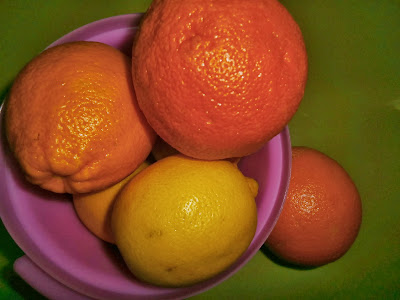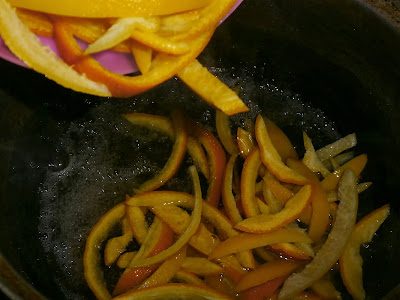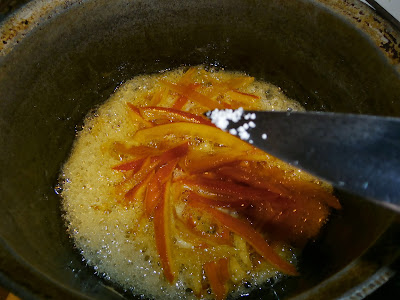De când am dat frâul liber pasiunii mele pentru gătit, am investit mult în tot felul de ustensile şi ingrediente, mi-am lăsat şi imaginaţia să mă ajute (intrepretând reţete, creând altele, improvizând în lipsa unor ingrediente sau materiale de împachetat) şi, încă un lucru foarte important, mi-am propus să îmi pregătesc singură, în limita imposibilului transformat în posibil, diferite ingrediente: extract de vanilie, extract de mentă, piure de castane, iar acum coji de citrice confiate. A fost o vreme când nu prea mă dădeam în vânt după cojile de citrice confiate din prăjituri, dar acum nu-mi pot imagina anumite reţete fără acest ingredient.
Când m-am hotărât să pregătesc pentru sărbători Dresdner Stollen, mi-am zis că e musai să încerc să confiez acasă coaja de portocale şi lămâi de care aveam nevoie. Dar cum timpul nu mi-a fost de prea mare ajutor (în sensul că timpul liber îmi lipsea aproape cu desăvârşire), am optat pentru metoda rapidă de confiere pe care am găsit-o aici – nu e chiar rapidă, adică îţi fură vreo câteva ore bune, dar nu zile întregi, ca metoda clasică. Spre deosebire de reţeta originală (unde se foloseau 5 portocale), eu am folosit 3 portocale şi 3 lămâi (tot 3 că erau mai micuţe), din care am obţinut cam 500 g coji confiate, de care m-am folosit pentru multe prăjituri în această perioadă.
COJI DE CITRICE CONFIATE
- 3 portocale
- 3 lămâi
- 450 g zahăr
- 250 ml apă clocotită
- 2 linguriţe sare
- 1 g sare de lămâie
Le
curăţăm apoi de pulpă şi le lăsăm bucăţi mari – eu le-am tăiat pe jumătate, am stors sucul,
apoi am curăţat resturile de pulpă cu ajutorul unei linguri.
Le punem într-o oală şi adăugăm 2-2,5 l apă
rece.
Dăm la foc potrivit, iar când începe să fiarbă reducem focul la minim şi fierbem 10 minute.
Dăm la foc potrivit, iar când începe să fiarbă reducem focul la minim şi fierbem 10 minute.
Schimbăm apa în care au fiert cu apă rece (tot
2-2,5 l), adăugăm 1 linguriţă de sare, le punem din nou în oală şi dăm la
fiert. Când începe să fiarbă, dăm focul la mic şi fierbem 10 minute.
Scoatem din nou cojile în sită sub jet de apă
rece, schimbăm apa (tot 2-2,5 ml apă rece), adăugăm 1 linguriţă de sare, punem
cojile înapoi în oală şi dăm pentru a treia oară la fiert. Când apa începe să
fiarbă, mai lăsăm la foc mic încă 10 minute.
Aruncăm apa din oală, punem zahărul şi apa
clocotită şi lăsăm să fiarbă – pentru ca siropul să nu se zaharisească odată
răcit (cum am păţit eu), trebuie să amestecăm pentru a topi zahărul înainte ca
siropul să înceapă să fiarbă.
Când siropul începe să clocotească, punem fâşiile de coji. Fierbem la foc potrivit cam 30-40 de minute – partea albă a
cojilor trebuie să fie transparentă, iar siropul trebuie să fie absorbit în
mare parte.
Turnăm totul (coji şi sirop) într-un borcan şi
păstrăm cojile aşa până când avem nevoie la diferite prăjituri. Atunci le
scoatem, le scurgem de sirop şi le tăiem cubuleţe, adăugându-le în aluat.
De asemenea, se pot consuma ca atare, în loc de bomboane.
Poftă bună!******************************************************************************************************
Ever since I gave free
reign to my passion for cooking, I invested a lot in instruments and
ingredients, I turned to my imagination for help (interpreting recipes in my
way, creating others, improvising when I lacked ingredients or wrapping
materials) and, very important, I decided to make, in the limits of possible,
my own ingredients like vanilla extract, peppermint extract, chestnut puree,
and now candied citrus peel. There was a time when I didn’t like them too much,
but now I can’t imagine some recipes without this ingredient.
When I decided to make for this Christmas the Dresdner Stollen, I said to myself that I must try to make candied citrus peel at home and to use them for this cake. But as I hadn’t too much time for this, I chose the quick way which I found here – not very quick actually, because it requires some good hours, but still not days like the classic process. Unlike in the original recipe (where were needed 5 oranges), I used 3 oranges and 3 lemons (they were smaller, that’s why I used 3 and not 2), and I obtained about 500 g candied peel, which I used for various cakes I baked during this period.
When I decided to make for this Christmas the Dresdner Stollen, I said to myself that I must try to make candied citrus peel at home and to use them for this cake. But as I hadn’t too much time for this, I chose the quick way which I found here – not very quick actually, because it requires some good hours, but still not days like the classic process. Unlike in the original recipe (where were needed 5 oranges), I used 3 oranges and 3 lemons (they were smaller, that’s why I used 3 and not 2), and I obtained about 500 g candied peel, which I used for various cakes I baked during this period.
CANDIED CITRUS PEEL
- 3 oranges
- 3 lemons
- 450 g sugar
- 250 ml hot water
- 2 teaspoons salt
- 1 g lemon salt
We wash the oranges and lemons (just as I described here).
We then remove the
pulp and leave them in large pieces – I cut them in half, squeezed them, then
removed what was left from the pulp using a spoon.
We put them in a pot
and add 2-2.5 l cold water.
We put the pot on medium
heat and when the water starts to boil we reduce the heat and boil for 10
minutes.
We put the peel in a
sieve under cold running water.
We change the boiled
water with cold water (another 2-2.5 l), add in 1 teaspoon salt and put back
the citrus peel. We let the water boil, then reduce the heat and boil for
another 10 minutes.
Just as before, we put
the peel in a sieve under cold running water, change the water (same 2-2.5 l
cold water), add in 1 teaspoon salt, put the peel back in the pot and boil for
the third time. When the water starts boiling we leave them on low heat another
10 minutes.
We put the peel in the
sieve, rinse them well with cold water and cut them in strips of 5 mm width.
We throw the boiled
water from the pot, add in the sugar and hot water and put them on heat – to prevent
the syrup to crystallize once cooled (as it happened to me), we should stir
well so the sugar is melted before the syrup starts to boil.
When the syrup started
to bubble, we add in the peel strips. We let them boil at medium heat for 30-40
minutes – the white side should become transparent and the syrup should be
almost entirely absorbed by the peel.
We add in the lemon
salt and stir gently.
We pour everything
(peel and syrup) in a jar and conserve the peel until we need it for various
cakes. We then take as much as we need, drain them in a sieve and cut them in
small pieces, which we add in the dough.
We can also eat them
as they are, instead of candies.

























Niciun comentariu:
Trimiteți un comentariu